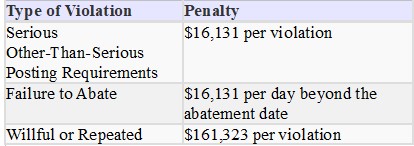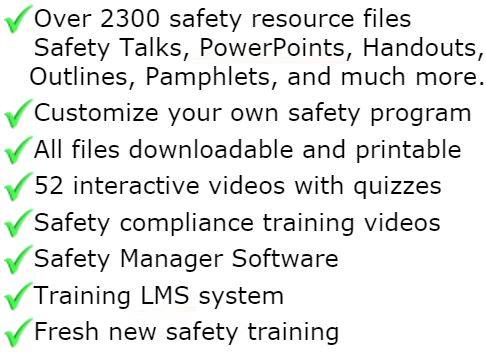
7 Step Plan For Safety Training Program Development
Step #1 - Determine Training Needs
Training does not solve all problems. Sometimes the problem may be work procedures, equipment, or lack of employee motivation. Ask yourself, “Could the employee do the job if he wanted to?” If the answer is “yes” then training may be less effective (but can still be used). “Does the employee have the skills or knowledge to perform the job?” If the answer is “no” then training will probably benefit the employee. Training may need to be done due to:
• Employee’s lack of knowledge;
• Employee’s lack of skills;
• New machinery or equipment;
• New procedures or job change; and
• Any aspects of behavior needing to be changed.
All new employees need to participate in an overall safety training orientation class. Every employee must be trained to be aware of and understand the hazards in their workplace. After you have determined that training will correct the problems and/or meet the legally mandated training, the next step is to identify the training needs.
Step #2 - Identify Training Needs
The purpose of training is to ensure that the employee will be able to perform the job correctly and safely. Some questions to help identify training needs are:
• Does the employee have previous experience?
• Does the employee know how to perform the tasks?
• Does the employee possess the skills to perform the tasks?
Once these questions have been answered, you can look at additional information to help identify specific training that needs to be done. Information to look at includes:
• Accident and injury records;
• Incident and near miss reports;
• Audits and inspections;
• Observing employees while working;
• Safety meetings;
• Suggestions from employees; and
• Job hazard analysis and developed solutions for the hazards (this is a very valuable tool to identify training needs).
As you work to identify the overall company training needs, you also need to determine which employees need training in what area. All employees do not have to be trained on all jobs. Train each employee on their job procedures and the overall safe way to perform that job. Each time an employee is assigned a new job procedure, train on the new procedure. Some variables to consider are:
• Employee age (younger employees have higher injury incident rates, especially in the first year);
• Length of time on the job (new employees have higher incident rates, especially in the first year);
• Is employee physically able to perform the task? (tall enough, short enough, strong enough, fit in the work space, etc.);
• Company size;
• Type of work to be performed:
• Specialized equipment;
• Personal protective equipment; and
• Any use of hazardous materials/substances?
After gathering and studying all of this material and information, you will have identified:
• Problem areas in the workplace;
• Tasks and skills needed to perform the job; and
• Employees needing training.
Step #3 - Identify Goals and Objectives
After determining training needs, it is time to identify your goals and objectives. When developing your goals, you should know exactly what you expect your employees:
• To do to perform their tasks;
• To do to improve their performance, and
• To do to improve their behavior.
Your objectives are the steps you will outline for employees to reach the company’s goals. Objectives need to be well thought out and planned for the training to be successful. Therefore, objectives should be clear, concise, measurable, and shared with the employees. The four elements to consider when developing your objectives are:
• Audience - identify who is going to receive the training.
• Behavior - what observable action will the employee exhibit during evaluation?
• Condition - under what circumstances will the desired action be performed? What materials and equipment will be used?
• Degree/Standard - how well must a task be accomplished? What score must be achieved?
As you develop your objectives, remember the four elements, and also ask yourself, “Will this help the employee reach the goal? Is it designed for the employee to be successful?”
Step #4 - Develop Learning Activities
You must decide what types of activities you’re going to use to train your employees. How are you going to get across to them the skills and knowledge they need? Different people require different types of training; some visual, some hands-on, etc. However, you must remember to use activities that will allow your employees to reach the goals and objectives. Prepare your training materials and aids after deciding on the learning activities. Arrange objectives and activities in the sequence that corresponds to the tasks actually performed on the job, and if possible, use hands-on demonstrations. Employees will retain training information if it is related to their job tasks.
Also consider the following:
• Determine your training method, (i.e., lecture, role-play, simulation, case-study, self- instructional, on-the-job, discussion, hands-on, homework, games, or a combination of several);
• Select media, (i.e., references, flip charts, diagrams, overheads, slides, films, videotapes, audiotapes, or computer based training); and
• Plan guides and tests, (i.e., instructor’s guide, student’s manual, pre-test, and post-test). Select the training methods that will best suit your audience and their training needs for optimum learning and retention. With proper planning and preparation, the goals and objectives will be met.
Step #5 - Conduct the Training
The actual training is crucial for the overall safety training process to be successful. Begin your training with a short review of the key training subjects and activities. After each objective is taught, draw a relationship between the employee’s goals, interests, and experiences to the objective. Reinforce what the employee has learned by summarizing objectives and key points. An effective training program allows employees to participate in the training process and to practice their new skills and knowledge in a safe environment. Allow employees time to:
• Participate in discussions;
• Ask questions;
• Share their knowledge and expertise;
• Learn through hands-on experience; and
• Participate in role-playing exercises.
Step #6 - Evaluate the Program
When you develop the objectives and contents of your training program, you will also develop a policy on how the training activities will be evaluated and the requirements for success. A training program is successful only if workers learn from it, accomplish the established objectives and reach the goals. Without evaluation, you will never know.
Your evaluation can include:
• Student opinion;
• Supervisors’ observations (both before and after training); and
• Workplace improvements.
From the evaluation, learning and performance improvement can be determined. If employees achieve the desired results, then the training should be offered in the future. If there is no change in behavior on the job, then the training needs to be improved.
The evaluation tool can identify strengths, weaknesses, and areas for improvement in both the training and the trainer.
Frequent program evaluation ensures that the training program information remains current and relevant to the employees.
You can use several methods of training evaluation:
• Tests (written or performance-based) can be taken at the end of the training or several weeks later;
• Supervisors may observe or interview the employee to determine job or performance improvements following the training;
• Reduced injury or accident rates indicate improved workplace performance; and
• Informal discussions may occur prior to the close of the training session.
Step #7 - Evaluate the Program
You can use the information from Step #6 to improve your training program. Training program revisions and improvements can be made based on the evaluation results. For example, revisions may be made in the program if the evaluation indicates that training materials were confusing, procedural steps were missed, or the employee failed to retain the information. The following changes should also prompt revisions in the training program:
• Job responsibilities;
• New equipment;
• New procedure; and/or
• New hazards.

GET INSTANT ACCESS
to THE MEMBERS LIBRARY
Safety materials created by safety professionals.
Access to the Safety Manager software.
Wide variety of safety videos and courses.
**Brand New** Safety Training Management System
Pre-Made Safety Materials Ready For Use
Created by experienced safety professionals & risk consultants. Saving you time, money, and risk of injuries.
95% of the work already done.
Below are the maximum penalty amounts, with the annual adjustment for inflation, that may be assessed after Jan. 15, 2024. (See OSHA Memo, Jan. 8, 2024).

**New OSHA HEAT 90 DAY**
>>Download Free HERE<<
**New 2024 OSHA 300 Form**
>>Download Free HERE<<
**Brand New**
Free with full membership subscription
Training LMS System
Ask The Safety Consultant
Safety Equipment Deal Finder

“SafetyInfo.com is the first go-to website for safety professionals and companies to use in establishing a solid safety program"
-Mike McKenzie, Certified Safety & Health Manager (CSHM), McSafety Solutions™
Note: You must have a full subscription to the Safety Library in order to use this material. Any use outside of your organization, for resell, or without an active membership is strictly prohibited and may result in prosecution under copyright infringement laws. Please contact us first, if you would be interested in reselling or using our materials for reproduction.
Inside the Members Library
Topic Index
Accident Prevention
Air Quality
Asbestos
Bloodborne Pathogens
Boilers
Chemical Safety
Compressed Gas
Confined Space
Construction
Construction Worksite
Cranes & Slings
Driver / Fleet Safety
Drug Free Workplace
Electrical
Emergency Management
Engineering Safety
Environmental
Equipment
Ergonomics
Fall Protection
Fire Safety & Prevention
First Aid
Flammable Materials
Forklifts
Hazard Communication
Hazardous Materials
Hearing Protection
Heat Stress
Hot Work
Housekeeping
Job Safety Analysis
Laboratory
Ladders
Lead
Lockout-Tagout
Machinery & Equipment
Material Handling
MSDS (SDS)
Medical & First Aid
Occupational Health
Office Safety
Off the Job Safety
Personal Protection
Process Safety
Record Keeping
Respiratory Protection
Silica Safety
Rules & Policies
Signs & Labels
Slips, Trips & Fall
Training
Terrorism Programs
Tool Safety
Vehicle & Driver
Violence Programs
Welding & Hot Work
Training Videos
Library Index
Training Materials
Videos/Courses
Talks
Articles
PowerPoint
Handouts
Training Overheads
Quizzes
Supervisor Briefs
Management Briefs
Safety Sessions
2 Minute OSHA Safety Talks
Pamphlets
First Aid Training
Supervisor Training
Hazardous Materials
Bomb Threat
Crossword Puzzles
Biological Agents
Forms & Documents
Forms
Checklists
Audit Guides
Inspections Guides
Signs & Labels
Environmental Audit Guides
Recordkeeping - OSHA 300
Sign & Label Maker
Safety Management Resources
Safety Manuals/Written Programs
Ergonomic Programs
Emergency Plans
Process Safety Management
Construction Safety
Occupational Health
Environmental
Topic Sheets
DOT Fleet-Driver
Hazardous Materials
Chemical Safety
Drug Free Workplace
Terrorism Programs
Development Guides
Safety Manager Software
Safety References & Graphics
Technical Safety Information
Posters
Topic & Fact Sheets
Development Information
Job Specific Safety Rules
Terrorism
Calculators
Safety Comic Strips
New Safety Training System
Schedule and train your employees with our materials. Add unlimited amount of employees. Record all progress and issue certificates. For group and individual training sessions.

